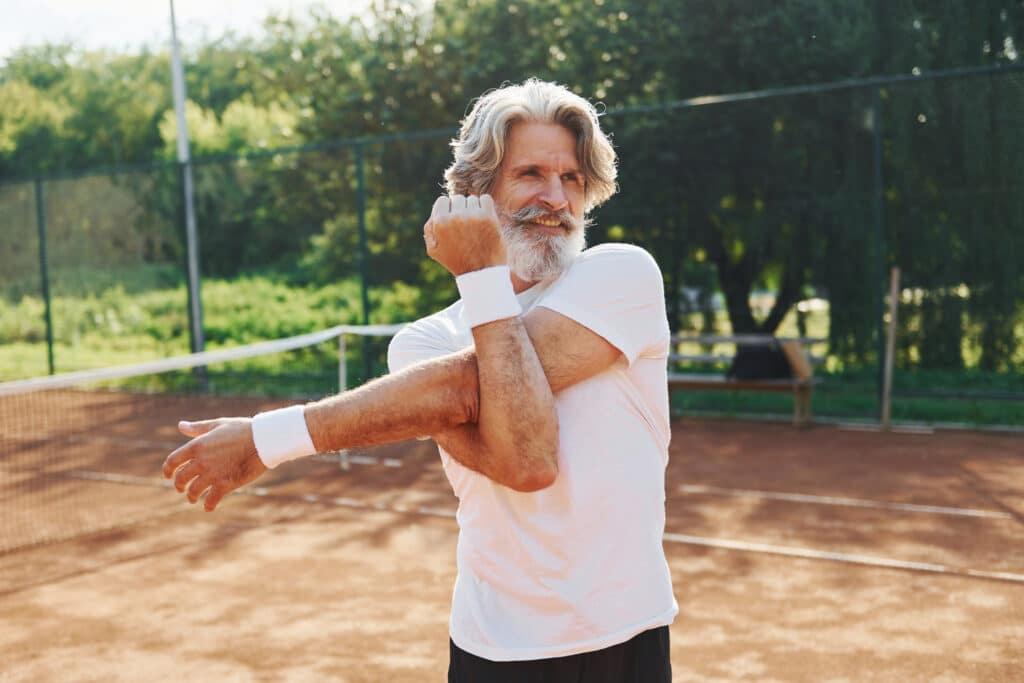Do your shoulders crack, pop, or feel tight when you move them? These sensations—often called shoulder crepitus—are common and can interfere with everyday comfort and range of motion.
By understanding what causes shoulder crepitus and how to address it, you can take meaningful steps toward improving shoulder function and reducing stiffness or pain.
In this updated guide, we’ll break down the key causes, warning signs, and treatment options for shoulder crepitus. You’ll also find simple, effective exercises designed to keep your shoulders strong, flexible, and pain-free for the long term.
What is shoulder crepitus?

Shoulder crepitus is a medical term for the sensation of crackling, popping, or grinding in the shoulder joint.
It’s common, especially as we age, and can be linked to various factors such as arthritis, previous injuries or surgeries, and our joints’ natural wear and tear over time.
These sounds occur when the surfaces within the shoulder joint rub against each other. Usually, our joints, including the shoulder, are well cushioned and lubricated, allowing smooth and silent movement.
However, as we age, the cartilage can wear down, and the joint fluid can decrease, leading to increased friction and the characteristic sounds of crepitus.
Who is most likely to experience shoulder crepitus?
Our joints naturally undergo more wear and tear as we age, which can contribute to the development of crepitus. It’s widespread among older adults who have led physically active lives.
If you’ve had previous shoulder trauma, injuries, or surgeries, you may be more prone to shoulder crepitus, stiffness, and muscle weakness.
Past damage to the ligaments, tendons, and other structures that enable the shoulder joint to function smoothly can affect its future operation.
For instance, I often see patients in their sixties with shoulder pain who were active baseball players or manual laborers in their younger years.
What Causes Shoulder Crepitus?

There are several potential causes of shoulder crepitus. Here are some of the most common ones.
Osteoarthritis
As we age, the cartilage in our shoulder joint may deteriorate. This can lead to friction, creating the characteristic crackling sounds of crepitus when the joint moves.
Additionally, the absence of smooth cartilage leads to bone-on-bone contact, which causes the crepitus sound and may also induce pain and stiffness in the shoulder.
Rotator Cuff Issues
The rotator cuff is a group of muscles and tendons that stabilize the shoulder. If these become inflamed or torn, it can lead to abnormal shoulder movement and crepitus.
A damaged rotator cuff can also restrict your range of motion and make everyday activities, such as raising your arm or carrying items, increasingly difficult.
Bursitis
The shoulder joint contains small fluid-filled sacs called bursae. If inflamed, these can cause a rubbing sensation or popping sounds during shoulder movement.
Bursitis often occurs due to overuse or direct trauma to the shoulder, leading to inflammation, pain, and redness in the area.
Injuries and Trauma
Past shoulder injuries, dislocations, or fractures can disrupt the joint’s regular structure, accelerating deterioration and contributing to crepitus.
Moreover, previous injuries may result in scar tissue formation, which can affect the joint’s motion and alignment, predisposing it to crepitus.
Overuse or Repetitive Movements
Engaging in repetitive shoulder movements, especially in sports or jobs that require overhead actions, can lead to wear and tear on the shoulder joint.
This can result in the crackling sounds associated with crepitus. It’s vital to monitor the strain put on the shoulder to prevent progressive damage and ensure joint longevity.
Muscle Imbalances
If the muscles around the shoulder are imbalanced, it can alter the joint’s mechanics and cause crepitus.
Maintaining balanced strength and flexibility among the shoulder muscles is essential to promote proper joint mechanics and avoid undue stress on the joint.
Synovial Fluid Changes
The shoulder joint is lubricated by synovial fluid. Changes in the viscosity or quantity of this fluid can affect the smoothness of joint movement, leading to the crackling sensations of crepitus.
This fluid’s primary function is to reduce friction between the joint surfaces, but its effectiveness may be compromised as its consistency changes.
Other Medical Conditions
Certain underlying medical conditions, such as rheumatoid arthritis or gout, can affect joint health and potentially lead to shoulder crepitus. Regular check-ups and awareness of one’s medical history can help identify and manage these conditions early, minimizing their impact on joint health.
Understanding the causes of shoulder crepitus can be the first step toward effective management and treatment.
Remember to consult with a healthcare professional if you’re experiencing any discomfort or changes in your shoulder movement.
Symptoms and Diagnosis

Shoulder crepitus can sometimes indicate an underlying condition within the joint. However, it’s not always a cause for concern. It might not be a significant issue if you’re experiencing shoulder crackling without any accompanying pain, stiffness, or subluxations.
The range of symptoms associated with shoulder crepitus varies. It can be as mild as slight discomfort or as severe as pain and limited movement. However, the hallmark of shoulder crepitus is the unnerving crunch you may hear when you move your arm.
Regardless, if you’re experiencing pain, a proper diagnosis is in order.
Typically, shoulder pain and stiffness are diagnosed through a physical examination. However, if a more severe issue is suspected, imaging studies like X-rays or MRI scans may be necessary.
Your healthcare provider can then determine the extent of the problem and recommend suitable treatment options.
Treatment and Management of Shoulder Issues
The treatment approach for shoulder pain, crepitus, or stiffness will depend on the underlying diagnosis. The good news is that many non-surgical treatment options are available for managing shoulder discomfort.
These can include physical therapy for strengthening and stretching exercises, over-the-counter anti-inflammatory pain medications, steroid injections, and lifestyle modifications.2
In some instances, surgical intervention may be necessary. This is particularly true for conditions such as a torn rotator cuff, labrum, or severe osteoarthritis. If the condition is painful or significantly impacts your daily life, your doctor might discuss suitable surgical options.
One of the primary reasons to determine the cause of your shoulder crepitus is to identify any issues early and take preventative measures to avoid potential surgery.
Physical therapy and targeted exercises can be highly beneficial in managing shoulder pain, stiffness, and crepitus. The primary goal is maintaining healthy, strong shoulders and supporting pain-free daily activities. Thankfully, there’s often no need to worry about performing exercises to stop the crackling sound and sensation if it is not affecting your daily function.
Later, we’ll explore specific exercises designed to strengthen the shoulder muscles, improve range of motion, and alleviate pain related to shoulder crepitus.
Preventive Strategies
Two primary strategies can help deter the onset of shoulder pathologies as you age. These include incorporating regular exercise into your routine and maintaining a diet supporting joint health.
The Value of Exercise for Shoulder Health
Appropriate and safe exercises are vital in preventing and managing shoulder injury. This is due to the numerous benefits of targeted physical activity for your shoulder joint health. Here are some of the primary reasons that exercise is so vital for shoulder health.
- Muscle Strengthening: Exercises focusing on the muscles around your shoulder joint, particularly the smaller muscles in your rotator cuff, can enhance stability and support. Strong muscles are better equipped to handle the forces exerted on the joint during movement, which can minimize wear and tear.
- Improved Range of Motion: Shoulder exercises can also increase your range of motion, making daily activities less strenuous on your joints.
- Enhanced Circulation: Regular physical activity promotes better blood circulation to the joints. This helps deliver essential nutrients and oxygen, which are vital in maintaining healthy joint tissues.
- Weight Management: Exercise is critical to maintaining a healthy weight. As discussed later, carrying excess weight can put undue stress on your shoulder joints, potentially leading to crepitus.
The Impact of Nutrition on Joint Health
A balanced diet, rich in nutrients, is a cornerstone of joint health, including your shoulder joints. Proper nutrition can support joint health in several ways3:
Vitamins C and D, found in many fruits and vegetables, and the omega-3 fatty acids in fish are essential for joint cartilage health. These nutrients help maintain the integrity of the cartilage that cushions the ends of your bones.
Foods rich in antioxidants, like berries, can help reduce inflammation. An anti-inflammatory diet can be beneficial since chronic inflammation can lead to joint issues.
Collagen, a protein that provides structure to joint tissues, can be supported by eating collagen-rich foods or taking supplements. This can promote the health of ligaments, tendons, and the joint capsule.
Adequate hydration is crucial for joint health. Water helps lubricate the joints and ensures that the synovial fluid, which enables smooth joint movement, remains viscous.
By implementing these preventive strategies—regular exercise and proper nutrition—you can significantly lower your risk of developing shoulder crepitus while promoting the long-term health of your shoulder joints.
Practical Exercises for Pain Relief and Improved Movement
Now, let’s dive into some practical exercises to help alleviate shoulder crepitus and improve mobility. These exercises will help to strengthen and mobilize the shoulder muscles and enhance joint flexibility.2
Narrow Arm Rows or Shoulder Blade Squeezes
Narrow Arm Rows
Note: This exercise requires a resistance band with handles.
- Stand or sit up straight, bring your arms straight out in front of you, and grasp the handles of your resistance band. It should be anchored to a stable structure.
- Pull your arms back while bending at the elbow. Squeeze your shoulder blades together as if you were trying to hold a pencil between them. Try not to arch your back, a common compensatory movement with this exercise.
- Hold for 5 seconds, then release. Repeat 10 times.
Shoulder Blade Squeezes
No resistance band? No problem! You can do the same exercise without the band. Simply focus on squeezing your shoulder blades together for each repetition.
Doorway Stretch
This exercise can be done in a doorway or in the corner of a room, as seen in the video
- Standing tall in a doorframe or near a corner, lift your elbows into a goal-post position.
- Placing your elbow and palms against the doorframe or wall, lean forward until you begin to feel a gentle stretch across your chest and shoulders.
- Hold for thirty seconds, then rest.
Key Takeaways
- Shoulder crepitus refers to crackling, popping, or grinding sounds in the shoulder joint.
- It is common in older adults and those with a history of shoulder injuries or surgeries.
- Causes include osteoarthritis, rotator cuff issues, bursitis, past injuries, overuse, muscle imbalances, and changes in synovial fluid.
- Symptoms range from mild discomfort to pain and limited movement, and proper diagnosis may require physical exams and imaging.
- Treatment options include physical therapy, medications, lifestyle changes, and sometimes surgery.
- Prevention strategies involve regular exercise and a balanced diet to support joint health.
- Specific exercises can strengthen shoulder muscles, improve range of motion, and reduce symptoms of crepitus.
- Consulting a healthcare provider is essential for proper diagnosis and treatment.
FAQs
What is shoulder crepitus, and what are the common causes?
Shoulder crepitus refers to the crackling, popping, or grinding sounds you might hear or feel when moving your shoulder joint. It is often caused by wear and tear of the joint, especially as we age. Common causes include osteoarthritis, where cartilage deteriorates; rotator cuff issues, such as tears or inflammation; bursitis, an inflammation of the fluid-filled sacs in the joint; past injuries that have disrupted the normal structure of the shoulder; overuse from repetitive movements; muscle imbalances; and changes in the synovial fluid that lubricates the joint.
Is shoulder crepitus something to worry about?
Shoulder crepitus is not always a cause for concern, particularly if there is no accompanying pain or significant stiffness. Many people experience these sounds as a normal part of aging. However, if the crepitus is accompanied by discomfort, restricted movement, or pain, it may indicate an underlying condition that requires attention. Consulting with a healthcare provider is recommended to rule out or address potential issues like arthritis, tendon tears, or other joint problems.
What are the best treatment options for shoulder crepitus?
Treatment for shoulder crepitus depends on its underlying cause. Non-surgical options often include physical therapy, which focuses on strengthening the shoulder muscles, improving flexibility, and enhancing joint stability. Over-the-counter anti-inflammatory medications may help reduce pain and inflammation. In more severe cases, steroid injections or surgical intervention, such as rotator cuff repair or joint replacement, might be considered. It’s important to work with a healthcare provider to determine the most appropriate treatment based on your specific symptoms and condition.
What exercises can help alleviate shoulder crepitus and improve shoulder health?
Exercises that strengthen and stabilize the shoulder joint can help alleviate shoulder crepitus. Effective exercises include narrow arm rows (or shoulder blade squeezes), which improve muscle strength and joint stability; and the doorway stretch, which enhances flexibility in the shoulder and chest muscles. Regularly performing these exercises can help reduce friction within the joint, minimize crepitus, and maintain overall shoulder health. Always focus on proper form and consult with a physical therapist if you have concerns about which exercises are best for you.
References
- Milton, Anamul Haque; Arefin, Samsul1; Khan, Khaja Javed2; Kasture, Jitesh Shivaji3; Amatya, Shirish Prasad4; Das, Gautam5. Scapulothoracic Bursitis or the Snapping Scapula Syndrome May Mimic with Shoulder Pain. Journal on Recent Advances in Pain 7(1):p 12-15, Jan–Apr 2021. | DOI: 10.5005/jp-journals-10046-0129
- Yuksel, E., & Yesilyaprak, S. S. (2024). Scapular stabilization exercise training improves treatment effectiveness on shoulder pain, scapular dyskinesis, muscle strength, and function in patients with subacromial pain syndrome: A randomized controlled trial. Journal of Bodywork and Movement Therapies, 37, 101-108. https://doi.org/10.1016/j.jbmt.2023.11.005
- Das, P. K., & Panja, D. (2013). Study of major factors developed among young swimmers during the practice session and competition causing interference of their performances. Journal of the Indian Medical Association, 111(12), 837–844.






